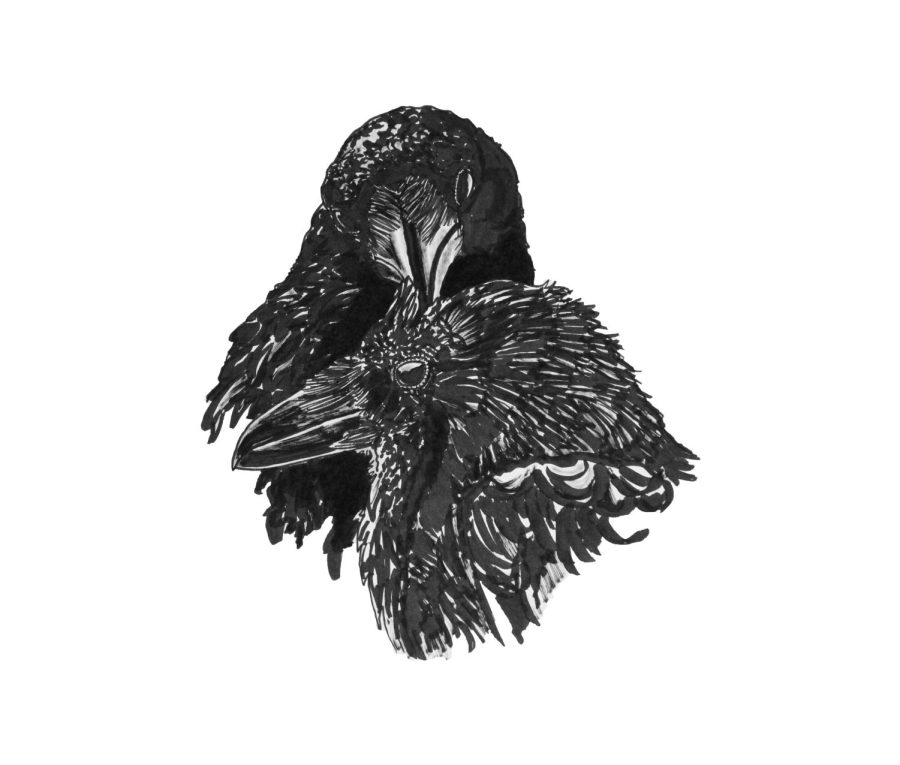The nature of love: examples of bonding in nature
Elephants, ravens, orcas, among others, exhibit traits of love in their species
Ravens engage in allopreening, a behavior that strengthens their romantic pair bonds.
February 10, 2022
Love is certainly in the spotlight this week. But what really is love? Why do we love, and are we the only species who can?
In the famed words of evolutionary biologist Theodosius Dobzhansky: “Nothing in biology makes sense except in the light of evolution.” Love must have an evolutionary explanation.
Natural selection favors advantageous traits. Individuals with such traits survive and reproduce at higher rates. One such trait is parental care, which increases the survival rate of offspring in many species.
However, this strategy is energetically demanding for the parents, according to researchers from University of Oxford and University of Tennessee. Caring for one offspring means fewer resources for others. Nevertheless, the benefits of parental care outweigh the costs throughout the natural world, from birds to mammals.
Eagles, grizzly bears and honey bees all invest resources to raise young. Highly social species like cetaceans and primates spend much longer periods caring for offspring than birds, whose parental duties usually last a mere few months.
Research suggests love evolved to maintain the long-term relationship between mother and offspring, according to the NOBA Project. Without a devoted parent, parental care is costly to both parent and offspring.
A mother elephant will care for her calf for over five years, according to PBS. She sacrifices the ability to reproduce for several seasons by devoting extra resources to increasing the fitness of one calf. Since elephants only reproduce once every several years, each calf is worth the work.
If maternal love is the ancestral form of love, the other types of love we experience must have evolved from it. Romantic love, friendship and family bonds are common in our daily lives. There are plentiful examples in nature.
Since love is an advantageous survival strategy, its widespread presence in nature makes sense. Monogamous pair bonds are fascinating examples.
Many species, especially long-lived ones like beavers, mate for life, according to the National Wildlife Federation. By reproducing with the same partner each year, an individual sacrifices a certain level of genetic variation in its offspring.
Despite the costs, monogamy is favorable for several reasons. It ensures access to a mate, reduces the chance of contracting harmful or lethal sexually transmitted diseases and encourages parental care, according to researchers from University of Michigan and Miami University. By cooperating, both parents remain healthier in the long run and produce fitter offspring.
Romantic love likely evolved to ensure cooperation between parents. In the avian world, ravens have complex pair-bonding rituals that strengthen ties with their mates, such as preening and vocalizing, according to Audubon. Albatross form lifelong bonds and can live for over seventy years, according to National Geographic.
Ravens also engage in friendship, according to researcher Bernd Heinrich. In his book “Mind of the Raven,” Heinrich details his observations of a pair of ravens who flew together each day. The pair did not mate, forage or claim territory. The only reason for their interaction, so far as Heinrich could deduce, was that they enjoyed each other’s company.
What evolutionary benefits does friendship provide? To find answers, an examination of the molecular basis of love is merited.
Oxytocin, commonly called the love hormone, is more accurately termed the bonding hormone. The release of oxytocin both prompts and physiologically rewards social interaction, protection of family members and infant care, according to the NOBA Project.
Oxytocin is not unique to humans. Extensive research has examined the similar role it plays in cats and dogs, which are able to cross the species barrier and form bonds with humans, according to the Atlantic.
Friendship is especially prominent in species with complex social structures, providing the best examples of familial love.
For orcas, family is a necessity. Family members protect each other, help raise calves and teach each other how to survive, according to National Geographic. By working together, the fitness of the pod increases as a whole, benefitting each individual in the light of selection.
Still not convinced? Perhaps the most obvious way to realize animals experience love is to observe their behavior in the face of loss.
Remember orca Tahlequah, whose calf died at birth in 2018? Refusing to let her baby go, she carried the body of her infant through the ocean, diving to retrieve it if it slipped off her back, according to National Geographic. She continued this grief-stricken behavior for 17 days.
Recognizing the strong bonds animals have with each other should be more than enough evidence to persuade even the fiercest doubters that love is alive and well in nature. This Valentine’s Day, take a moment to appreciate the inspiring bonds between our fellow creatures.











